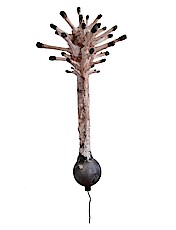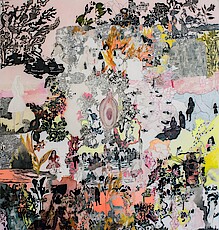Natural rebel: Tamara De Laval and Charlotte Petersen


In dialogue with the site's halls, the visual artists Tamara de Laval (S) and Charlotte Petersen (DK) have staged an exhibition on dreams and living spaces. As they say: Our exhibition likes people! Already outside the house, you meet a “Blomsterköje” (willow hut), for Tamara de Laval wants to show the growth of nature and create hope.
In general, the two artists, with their works, want to make room for the soul and life force that they experience have narrow conditions in today's troubled society and the looming crisis caused by human predation on nature.
The Swedish critic in arts and literature Barbro Westling looks at man's greater and greater separation from a deeper nature, she writes, among other things, in her catalogue text:
“We usually look at nature as harmony, consonance and balance, as opposed to culture's jumble and conflicts. Perhaps this is partly the reason why the adjective naturally is a word that arouses distrust, perhaps even offending. Simply because the natural has become alien to us.
When we talk about man as an animal, it is rarely something positive. We can eat like pigs, follow our reptile brain, act like hyenas or stare like cows. But the beast in us need not be matched by caricatures of the primitive. Recent research has shown that other sides of our inner pack animal can also rely on individuals who cooperate with others.”
Charlotte Petersen is experimenting with her expression formats, and often mixes several, preferably unconventional elements, into new entities such as the breathless fitness machine, which is now included as an artistic building block in the mobile "Peace and freedom". Several of her works and films revolve around the animal in man / man in the animal. A human deer symbolizes this desire for a better balance.
Tamara de Laval has developed a seductive, colorful and complex imagery in which layers upon layers and many fields of image contribute to a unified narrative of a world of disasters and breakdowns shown, for example, with ruins and fleeing people, the distant symbolized by card cuts, growth and the close, sometimes bounded in entirely white lots.
The exhibition includes painting, installation and sculptural works as well as several art films.


In dialogue with the site's halls, the visual artists Tamara de Laval (S) and Charlotte Petersen (DK) have staged an exhibition on dreams and living spaces. As they say: Our exhibition likes people! Already outside the house, you meet a “Blomsterköje” (willow hut), for Tamara de Laval wants to show the growth of nature and create hope.
In general, the two artists, with their works, want to make room for the soul and life force that they experience have narrow conditions in today's troubled society and the looming crisis caused by human predation on nature.
The Swedish critic in arts and literature Barbro Westling looks at man's greater and greater separation from a deeper nature, she writes, among other things, in her catalogue text:
“We usually look at nature as harmony, consonance and balance, as opposed to culture's jumble and conflicts. Perhaps this is partly the reason why the adjective naturally is a word that arouses distrust, perhaps even offending. Simply because the natural has become alien to us.
When we talk about man as an animal, it is rarely something positive. We can eat like pigs, follow our reptile brain, act like hyenas or stare like cows. But the beast in us need not be matched by caricatures of the primitive. Recent research has shown that other sides of our inner pack animal can also rely on individuals who cooperate with others.”
Charlotte Petersen is experimenting with her expression formats, and often mixes several, preferably unconventional elements, into new entities such as the breathless fitness machine, which is now included as an artistic building block in the mobile "Peace and freedom". Several of her works and films revolve around the animal in man / man in the animal. A human deer symbolizes this desire for a better balance.
Tamara de Laval has developed a seductive, colorful and complex imagery in which layers upon layers and many fields of image contribute to a unified narrative of a world of disasters and breakdowns shown, for example, with ruins and fleeing people, the distant symbolized by card cuts, growth and the close, sometimes bounded in entirely white lots.
The exhibition includes painting, installation and sculptural works as well as several art films.
